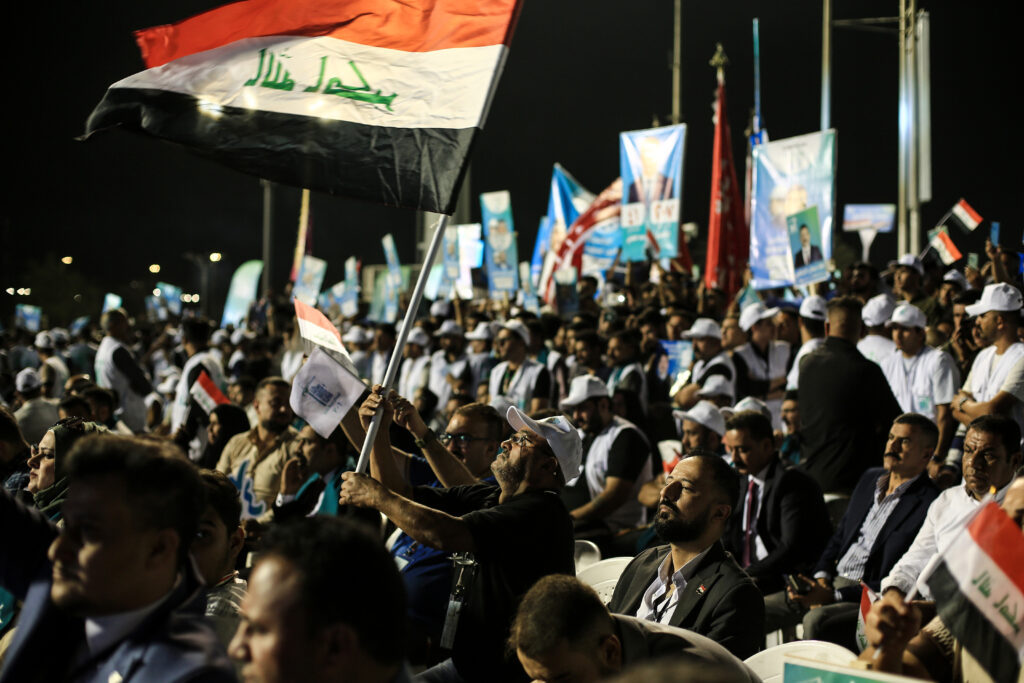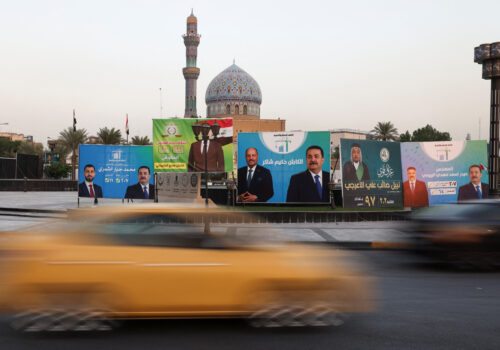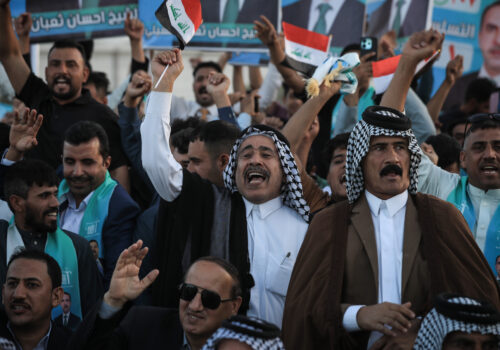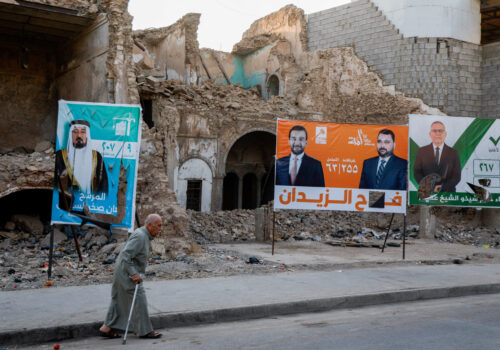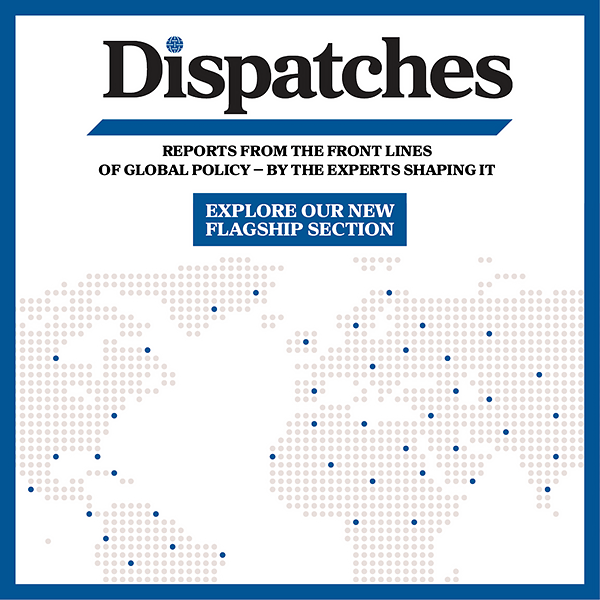The voting is over, but the maneuvering could go on for a while. In Iraq’s parliamentary elections on Tuesday, the bloc led by Prime Minister Mohammed Shia’ al-Sudani won the most seats, but it will need the backing of other parties to form a government. Tuesday’s vote came amid pressure from the Trump administration to crack down on Iran-backed militias operating in the country and questions over whether Shia cleric Muqtada al-Sadr’s call to boycott the elections would depress turnout. Below, our experts examine what the elections mean for the future of Iraqi politics and Baghdad’s role in the region.
Click to jump to an expert analysis:
Victoria J. Taylor: His coalition may have won, but Sudani faces stiff opposition to a second term
Safwan Al-Amin: What to watch from the Iraqi Higher Electoral Commission
Yerevan Saeed: The KDP remains the dominant party in the Kurdistan region
Rend Al-Rahim: The elections consolidated the grip of Iraq’s traditional parties
His coalition may have won, but Sudani faces stiff opposition to a second term
While Sudani’s Reconstruction and Development bloc did very well throughout southern Iraq, translating his high approval into votes, he still appears to have fallen short of the overwhelming victory he likely needed to guarantee a second term as prime minister. In the weeks ahead of the election, Sudani launched a public relations offensive in the Western press. He published an op-ed in the New York Post and gave interviews to Bloomberg and Newsweek aimed at securing US and international support for a second term, making a pitch for his “Iraq first” agenda.
However, the days of decisive US engagement in the government formation process are likely over. For Sudani to secure a second term, he will have to do so the old-fashioned way by building a coalition. Although popular among the public, Sudani does not have ready alliances among the other major Shia parties and coalitions. The two largest Shia blocs after Sudani’s are former Prime Minister Nouri al-Maliki’s State of Law Coalition and the Al-Sadiqoun Bloc (which is affiliated with the US-designated Foreign Terrorist Organization Asa’ib Ahl al-Haq) both of which oppose giving Sudani a second term.
—Victoria J. Taylor is the director of the Iraq Initiative in the Atlantic Council’s Middle East programs.
A higher turnout than expected, especially in predominantly Sunni and Kurdish provinces
Contrary to what many Iraq watchers expected, myself included, the initial results—if accurate—suggest that more Iraqis were motivated to vote this time. Turnout reached almost 56 percent of registered voters, according to Iraq’s electoral commission, a notable jump from 43 percent in 2021. However, part of this increase is tempered by the fact that there were 700,000 fewer registered voters than in 2021, even though nearly four million Iraqis have reached voting age since then. In other words, while the voter pool shrank, the absolute number of ballots cast actually grew.
Another striking development is the geographic variation in turnout. Whereas participation in 2021 was uniformly low across all provinces, Tuesday’s vote revealed new patterns: Turnout was significantly higher in predominantly Kurdish and Sunni provinces than in Shia-majority areas. This divide was also evident within Baghdad, between the mostly Sunni western and Shia eastern banks of the Tigris. In 2021, the gap between the provinces with the highest and lowest turnout—Duhok and Baghdad—was more than 20 percent; this time, it widened to a 36 percent gap between the highest turnout in Duhok and the lowest in Sudani’s home province of Maysan.
With party platforms largely devoid of real policy proposals, were the shifts driven mainly by more effective mobilization through tribal and patronage networks? Or were they primarily driven by a more genuine sense of stability and renewed hope among voters? A deeper analysis will be needed to explain these shifts.
—Omar Al-Nidawi is a nonresident senior fellow with the Iraq Initiative in the Atlantic Council’s Middle East programs. Al-Nidawi is also the director of programs at the Enabling Peace in Iraq Center, where he co-develops and leads research and field initiatives focused on governance, peacebuilding, and climate action in Iraq.
What to watch from the Iraqi Higher Electoral Commission
At this point, the only official information released by the Iraqi Higher Electoral Commission (IHEC) relates to voter turnout. IHEC put voter participation at around 56 percent. What is noteworthy is that IHEC only counted those who obtained or renewed voter registration cards as eligible voters, and did not count those who failed to so or intentionally boycotted as eligible voters.
This participation level is still higher than most had expected given that there was a strong boycott campaign led by al-Sadr as well as other smaller political movements. Initial leaked results show that the established parties maintained most of their seats, with Sudani’s coalition being the new big entrant. The smaller liberal parties appear to have lost momentum. Most of this is by design and a result of the electoral system the main parties reverted to when they amended the election law in 2023. We should also keep an eye on the potential post-results exclusion of candidates by IHEC, which could potentially change the results.
—Safwan Al-Amin is a nonresident senior fellow with the Iraq Initiative in the Atlantic Council’s Middle East programs.
The KDP remains the dominant party in the Kurdistan region
Preliminary election results reaffirm the Kurdistan Democratic Party’s (KDP’s) political dominance in the Kurdistan region. It garnered more than one million votes and secured twenty-seven seats while its rival, the Patriotic Union of Kurdistan (PUK) received roughly half as many votes but still increased its share of seats from seventeen to eighteen. When compared to last year’s Kurdistan Regional Government (KRG) election, the PUK’s votes declined in areas under KRG jurisdiction, while the KDP’s increased. Outside KRG-controlled territory, the PUK won four seats in Kirkuk while the KDP emerged as the leading party in votes and seats in Nineveh province. This will further challenge the PUK’s influence in areas beyond the KRG’s authority. In addition, five minority-quota candidates backed by the KDP across Iraq also won seats, further strengthening the party’s leverage at the federal level.
New actors also made gains. Halwest won five seats, while New Generation, which previously held nine seats, dropped to four. The two main Islamist parties maintained their previous share seats of four and one seats respectively. Despite these shifts, the broader electoral map in the Kurdistan Region remains largely intact. Most changes in seat distribution occurred among smaller, antiestablishment parties within the PUK’s traditional areas of influence. The PUK had aimed to win back voters and reclaim seats in these strongholds, many of which it has gradually lost over the past fifteen years to emerging parties. Instead, a familiar pattern persisted: Voters in PUK-dominated areas continue to be more inclined than others to experiment with and switch to new political forces.
These results are likely to embolden the KDP to hold firm on its terms for forming the new KRG cabinet. This, in turn, could affect government formation in Baghdad, given that the KDP is now among the top three blocs in terms of seats at the federal level and can wield significant influence over the Iraqi presidency, a post traditionally held by the PUK since 2003. At the same time, negotiations over the new federal government in Baghdad could make the pie larger for the KDP and PUK, enabling them to reach compromises on key issues and ministerial portfolios that might facilitate the formation of a government in the KRG. The central question is whether the PUK will accept a government in Erbil that reflects its actual votes and seats or continue to insist on a fifty-fifty power-sharing arrangement based on territorial control.
—Yerevan Saeed is a nonresident senior fellow with the Iraq Initiative in the Atlantic Council’s Middle East programs. Saeed is the Barzani scholar-in-residence in the Department of Politics, Governance & Economics at American University’s School of International Service, where he also serves as director of the Global Kurdish Initiative for Peace.
The elections consolidated the grip of Iraq’s traditional parties
No clear winner emerged from the November 11 parliamentary elections. The forty-five seats gained by Sudani’s bloc did not represent the landslide his supporters had hoped for. Nevertheless, this was a significant improvement on the two seats his party occupies in the outgoing parliament. The KDP and Mohamed al-Halbousi’s Taqaddum coalition also made gains. Sadiqoun, the political arm of the Asaib Ahl Al-Haqq militia expanded its presence in Parliament, as well. The big losers were smaller parties, independents, and liberal/secular candidates, who didn’t stand a chance under the 2023 changes to the election law and the massive sums spent by the big parties and candidates. Another loser is Muqtada al-Sadr, whose call for a boycott clearly went unheeded, and who has been marginalized by the elections and needs to find new relevance. Despite popular calls for change, the elections brought no new blood but consolidated the grip of the traditional parties.
The next phase is the process of forming a government. Sudani’s postelection address sounded like an acceptance speech, but it is far from certain that he will serve a second term as prime minister. Negotiations to create the largest parliamentary bloc will be contentious. A grand alliance of Sudani’s bloc with the KDP and Taqaddum, such as was attempted by al-Sadr in 2021, is now even more far-fetched. Instead, the Shia Coordination Framework coalition is likely to declare itself the largest parliamentary bloc and claim the right to nominate the new prime minister, and many members of this bloc are adamantly opposed to Sudani. While the Shia Coordination Framework can nominate, the high number of seats won by the KDP and Taqaddum will give the latter two blocs a powerful countervailing voice over the nomination. Iranian and US influence will also be elements in the nomination process. In previous Iraqi government formation cycles, there was tacit agreement between Washington and Tehran. But the Trump administration, with its confrontational posture toward Iran, will likely make such an agreement difficult to reach, thus prolonging the government formation process.
—Rend Al-Rahim is a nonresident senior fellow with the Iraq Initiative in the Atlantic Council’s Middle East programs.
Further reading
Mon, Nov 10, 2025
Dispatch from Baghdad: Don’t confuse the calm around Iraq’s election with stability
Dispatches By Yerevan Saeed
Iraqi society faces several slow-burning stressors, from water and climate problems to over-centralization and narcotics trafficking.
Tue, Nov 4, 2025
Twelve questions (and expert answers) on the Iraq elections
MENASource By
Iraq is set to hold elections on November 11. Our experts unpack the key questions looming over the landmark vote.
Fri, Oct 31, 2025
Inside the divides of Iraq’s Coordination Framework—and why they matter ahead of landmark elections
MENASource By Rend Al-Rahim
The November election will not necessarily determine who the next prime minister will be, but it will provide an opportunity to shift power dynamics within the fractious Shia bloc.
Image: People gather at Baghdad's Grand Festivities Square during a campaign rally by the Reconstruction and Development Coalition of Iraqi Prime Minister Mohammed Shia' al-Sudani, ahead of the Iraqi parliamentary elections, scheduled to be held on 11 November 2025. Ameer Al-Mohammedawi/dpa via Reuters Connect.
